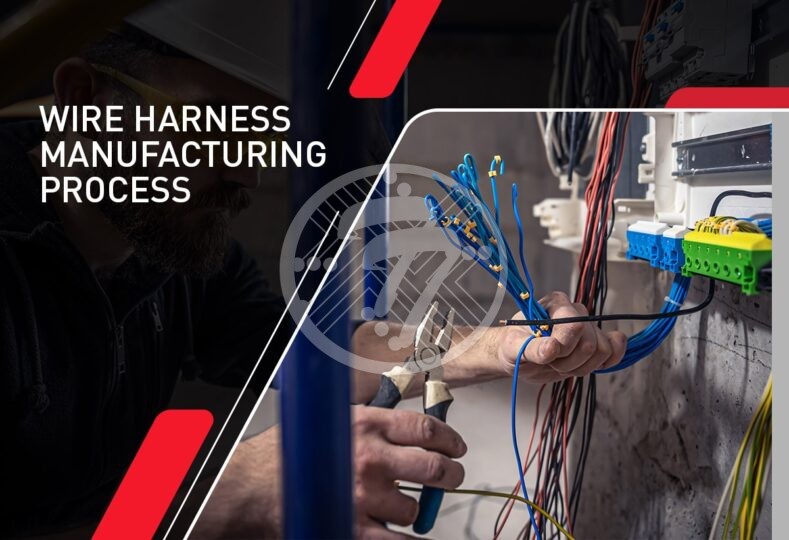Wire Harness Manufacturing Process – A Step by Step Guide

The demand for wire harnesses continues to grow and with it we need to understand the manufacturing process of this critical component in detail. Before we offer a step-by-step guide to the manufacturing process, let us look at what wire harness assemblies are and what are the benefits of their use.
What are Wire Harness Assemblies?
Simply put wire harness assemblies are the bundled processed wires with a protective sheath. Harnesses are important as they organize wires for easy implementation. They are different from cable assemblies in that cable assemblies bind multiple covered wires with a covering to provide protection in harsh environments. Make the right choice between cable assemblies and wire harness assemblies.
The benefits of wire harness assemblies include:
- They help optimize space.
- They help in customization basis the bespoke need of the appliance.
- They help in improving equipment safety.
- They improve the life of custom cable assemblies and wires.
Wire Harnesses find extensive application in a wide variety of appliances including but not limited to:
- Automotive
- Flight Simulators
- Panel Displays
- Heavy equipment and more
Step-By-Step Guide of the Wire Harness Manufacturing Process:
Wire Harness Design
The manufacturing process, of course, begins with the design aspect. The wire harness needs to be custom designed for each product. What is also imperative is to choose the components of the harness carefully and be mindful of all specifications.
Wire Harness Prototyping
Since the wire harness plays a critical role, prior testing is mandatory. What this means, is to create a functional prototype so that the harness can be tested in its intended application. This way you can be sure about the harness before beginning the first production run and there are no costly errors to contend with at a later date.
Wire Harness Production & Assembly
The production of the wire harness leaves little room for error, so all design specifications need to be met. It is important to remember that despite some level of automation, the manual assembly still plays an important role in the wire harness manufacturing process. This is on account of the fact, that wire harnesses and cable assemblies involve some intricate steps that need manual intervention. Since wire harnesses need to be customized for individual applications, the role of manual assembly further increases. They resolve geometric and electrical issues in the products. They also ground and protect wires from both external and internal damage. Also, the advantage of manual production is its cost-effectiveness.
Broadly speaking, the steps involved in building the wire harness involve:
- Cutting the wires to the right length with a wire cutting machine.
- Stripping the wire ends to be able to attach the terminals or connectors.
- Gathering the wire into a harness meeting the design specifications. Manual processes involve routing the wires through the sleeves, crimping the terminals onto the wires, insertion of one sleeve into the other, fastening strands etc.
- There is some amount of automation involved too as cutting machines are used to cut the wires to specified lengths. The use of machines is also in crimping terminals. Besides, solder machines are used to seal the wire ends.
Wire Harness Testing
Post production, comes the important stage of testing where each wire harness goes through a process of safety testing. This is a crucial process as it ensures that the product performs up to its potential. The harness needs to be checked for continuity as also for construction and labeling.
To sum up
It is important to remember that the more detailed your documentation is the fewer issues will be faced on the assembly floor. Some of the information that should be provided to the contract manufacturer includes:
- Detailed images of connectors along with the pin locations
- Wire lists
- Bill of Materials
- Assembly Drawing
- Testing Specifications
The contract manufacturer will be in a position to offer a number of recommendations to do with the following aspects:
- Termination recommendations on how the wires should be attached- such as stripped and bare or stripped and tinned.
- Torque values on wire harness components and fasteners.
It is advisable that you give generic specifications for the wires. That way the PCB manufacturer can go with what works best for the harness and what is cost-effective. With due attention paid to the above issues you can ensure that you help speed the overall manufacturing process as also receive a quality product.
At Technotronix, we have 40 years of experience in manufacturing and assembling industry-leading printed circuit boards, cable, and wire harness assemblies. Equipped with state-of-the-art equipment and skilled personnel, we offer wire harness assemblies to meet your bespoke requirements. Technotronix can be your trusted PCB manufacturer who will give you ample smart solutions related to printed circuit boards.






